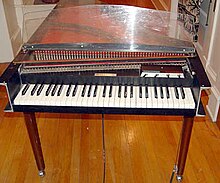Baroque pop
| Baroque pop | |
|---|---|

|
|
| Stylistic origins | |
| Cultural origins | 1960s, United States and United Kingdom |
| Typical instruments | |
| Derivative forms | |
| Other topics | |
| List of baroque pop artists | |
Baroque pop (or baroque rock) is a pop music subgenre that fuses classical music, orchestral pop, rock, and Baroque music. It is identifiable for its use of contrapuntal melodies, functional harmony patterns, and dramatic or melancholic gestures. The genre emerged in the 1960s after pop musicians and record producers began placing the harpsichord in the foreground of their arrangements. Other typical baroque pop instrumentation includes string sections, French horns, and oboes.
Baroque pop's mainstream popularity faded by the 1970s, partially because punk rock, disco and hard rock took over; nonetheless, music was still produced within the genre's tradition.Philadelphia soul in the 1970s and chamber pop in the 1990s both incorporated the spirit of baroque pop while the latter contested much of the time's low fidelity musical aesthetic.
In classical music, the term "Baroque" is used to describe the art music of Europe approximately between the years 1600 and 1750, with some of its most prominent composers including J. S. Bach and Antonio Vivaldi. Much of the instrumentation of baroque pop is akin to that of the late Baroque period or the early Classical period, chronologically defined as the period of European music from 1690 to 1760 and stylistically defined by balanced phrases, clarity and beauty, using instrumentation similar to modern orchestras.
...
Wikipedia
